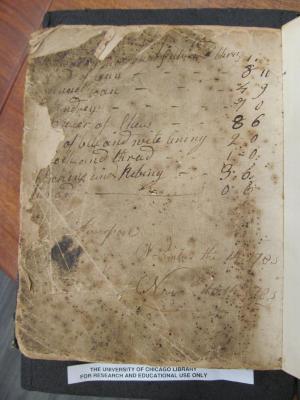Liverpool Recipe Book, dated 1783
View Catalog Record
[Library Title: Collection of recipes : manuscript, [ca. 1783].]
[Library Title: Collection of recipes : manuscript, [ca. 1783].]
Holding Library Call No.
CrMs113Manuscript Cookbooks Survey Database ID#
1398Place of Origin
England ➔ LiverpoolDate of Composition
1783Description
Written in many hands, this recipe book of 189 written pages may have been compiled among a circle of friends. Most of the recipes are culinary, with some medical and household recipes interspersed. The English city of Liverpool and the date “November the 14 1783” are inscribed on the final page, along with a list of sewing fabrics and notions with prices. The date may reflect when the book was completed, as the hand of the date seems to match the hand of some recipes that appear near the end of the manuscript. Some recipes are attributed, including “bals for the lungs” from Lady Lucy Pelham, “Mrs Bridgetts Cake,” and “Aunt Bonyers nice Receipt to preserve golden Pippens.”
The culinary recipes include “Pease Soup for Lent or any fasting day,” hashed calf’s head, potted and pickled meats, pickled cucumbers, and pickled delicacies like elder flower buds, broom buds, and ash keys (immature seeds of the ash tree). There are also recipes for fresh cheese, cakes, syrups, and wines, including birch and elder. There are recipes for preserved fruits in most of the hands. Some of the recipes are unusually specific and detailed for the period. A recipe for French bread, for example, includes measures for all ingredients, and a recipe for cheese specifies the temperature of the cream and milk as “Blood warme.”
Among its medical recipes, the book records two that are particularly well known: a cure for scurvy, useful in a major English port city like Liverpool, and a cure for the bite of a mad dog.
The book is bound in black leather. The pages are heavily stained, and many are torn or worn away at the edge, particularly in the front.

